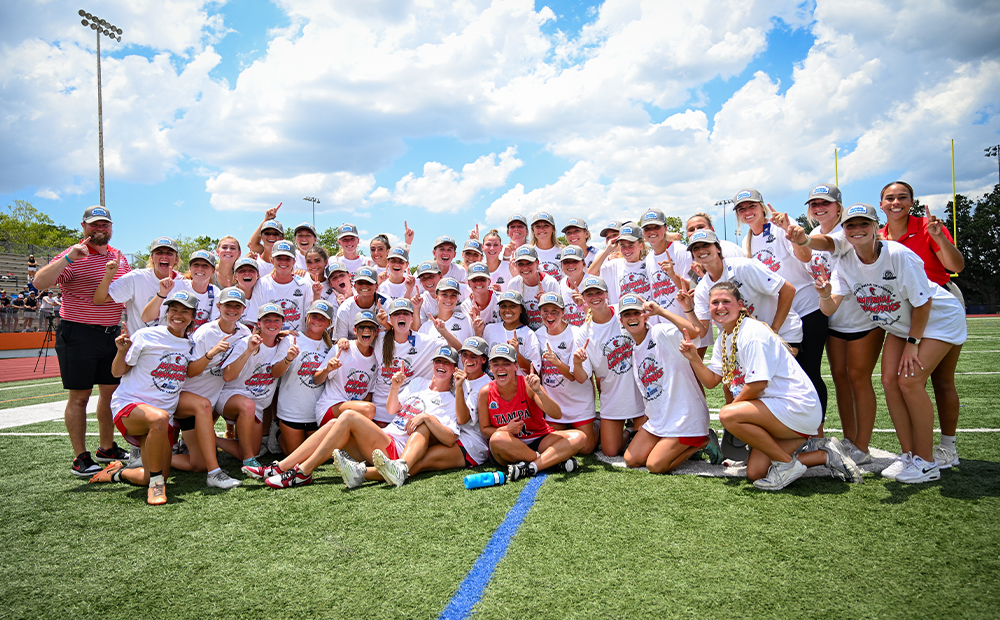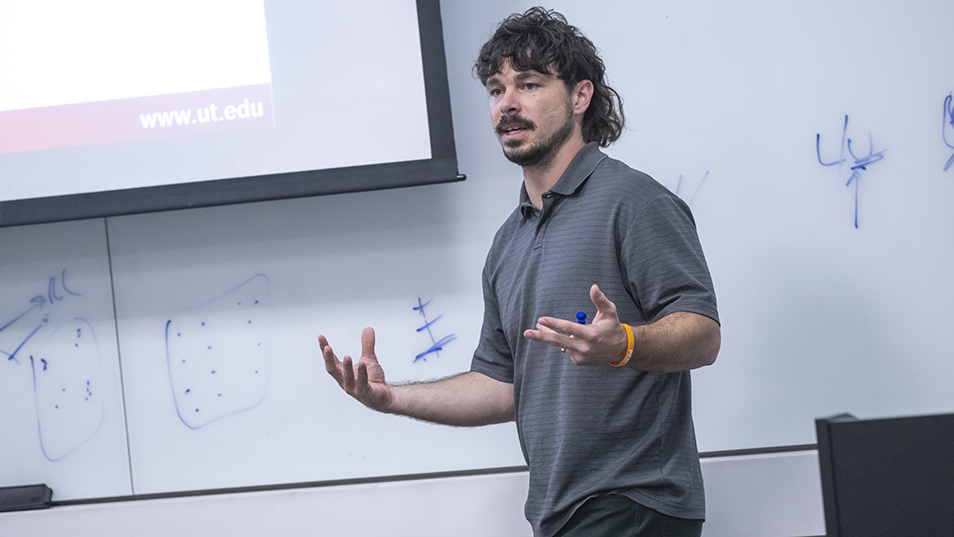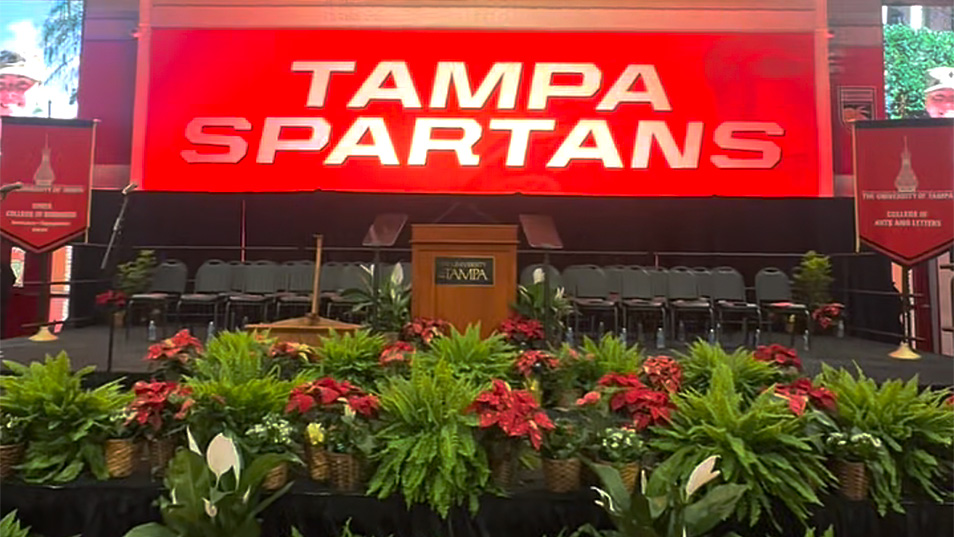University of Champa
Four national championships have Spartans ‘on top of our game’

Here’s something Spartans can say a lot: “We’re No. 1!” Photo courtesy of University of Tampa Athletics
SPRING SPECTACULAR
Men’s swimming started the party, and then the trophies kept coming for the Spartans all last spring. Beach volleyball repeated at the AVCA small college national championship; women’s lacrosse won it all for the first time; and baseball added a Div. II record-tying ninth national title.
Some highlights from the national championships:
Men's swimming: Men’s swimming won the NCAA Div. II National Championship in March, and head Coach Jimi Kiner ’01 was named NCAA Div. II men’s swimming coach of the year by the College Swimming and Diving Coaches Association of America. Both accomplishments are firsts for the UTampa program that started in 1977. The Spartan 800-yard freestyle relay team of Caleb Brandon ’24, Parker Kollman ’25, Jacob Hamlin ’27 and Santiago Corredor ’24 set the pace from the first event, winning in a new school record time of 6:20.78. By the end of the five-day meet held in Geneva, Ohio, 13 school records had been broken 16 times.
Beach volleyball: In April, the Spartans defeated Concordia Irvine (CA) in the finals, 3-2, in the AVCA small college national championship tournament. They advanced to the final round with a 3-1 semifinal win over Colorado Mesa, the team they defeated in last year’s finals. The win was the first back-to-back championship for UTampa, which has earned the AVCA trophy four times in the program’s seven-year history.
Women’s lacrosse: UTampa defeated Adelphi University (NY) in the final of the Div. II national championship in May. The coaching staff was named the national and south region Coaching Staff of the Year by the Intercollegiate Women’s Lacrosse Coaches Association (IWLCA). Four Spartan players were named All-Americans; seven earned IWLCA All-Region accolades; and eight made all-Sunshine State Conference teams.
Baseball: The Spartans defeated Angelo State (TX), 8-3, in the final of the NCAA Div. II baseball championship in June. Coach Joe Urso ’92 collected Div. II national coach of the year awards from the American Baseball Coaches Association and the National College Baseball Writers of America. Graduate student-athlete E.J. Cumbo ’22 became just the third player to record 400 hits in the history of NCAA baseball. He was named the Div. II player of the year.
The Bob Martinez Athletics Center was quiet and seemingly empty as the bus carrying the women’s lacrosse team arrived on campus on the evening of May 25.
The Spartans had just won their first national championship and had celebrated on the field in Winter Park a few hours earlier. It was time to get off the bus, unload the equipment and go their separate ways as another offseason began.
But the celebration wasn’t quite over. The champions were greeted by someone who was in the middle of his own championship run.
“(Baseball Coach) Joe Urso was in the office getting ready to go to Cary (North Carolina) to play for a national championship,” women’s lacrosse Coach Kelly Gallagher said. “But he took the time to come down and give every kid a high five and congratulate them. It just shows that we’re all part of one very big team.”
One very successful team. Earlier that day, Urso’s team had won the NCAA Div. II Super Regional to advance to the NCAA Championship series. Exactly two weeks and four wins later, Urso and the baseball team capped off the most exceptional year in the history of UTampa athletics by winning a national championship of their own.
In the 2023-2024 academic year, the Spartans won national titles in four sports — women’s lacrosse, baseball, men’s swimming and beach volleyball. A few years back, the Tampa Bay Buccaneers, Lightning and Rays all were contending for championships, and the phrase “Champa Bay” was coined. These days, it might as well be the “University of Champa,” where excellence is sustained over time. UTampa athletic teams have captured 14 national titles since 2013.
“We’re on top of our game as a school right now,” said Urso, who helped UTampa win the first of its nine national titles in baseball as a player in 1992 and has coached the Spartans to six national championships. “Everybody in the athletic program — and I mean everybody — works together to make us the best. We’re all in it together because success in one sport means success in all sports.”
SEE ALSO:
For Urso, It’s All About Family
National Champions Visit the White House
The Spartans finished fifth in the 2023-2024 Learfield Director’s Cup, which uses results in 15 sports to rank athletic programs. That tied the school-best finish in the 2007-2008 academic year.
“The way it is at Tampa now in all sports is that you’re only recognized as a great team if you win it all,” Urso said. “Other schools get rings for winning a conference championship. I can’t even imagine going to Larry and asking for a conference championship ring.”
“Larry” is Athletic Director Larry Marfise, and coaches point to him as the main reason for the Spartans’ success. In his 23 years at the University, the Spartans have won 18 national championships.
So what’s the formula for making UTampa into one of the top athletic programs in all of college sports?
“The secret is to hire good coaches and stay out of their way,” Marfise said.
But while Marfise likes to deflect the credit for UTampa’s success, a quick look at the athletic program reveals some Marfise tendencies that have played a large part.
“I don’t want coaches who are just coaches,” Marfise said. “I want coaches who are also teachers. At the Division II level, you’re working with student-athletes that haven’t hit their full athletic potential, and you have to be able to teach in order for them to develop.”
Marfise doesn’t have any hard and- fast rules about what he looks for on the résumés of coaching candidates, but it’s obvious he likes to stay within the Spartan family. Many of his coaches are former Spartans.
“I’ve been around UT since 1997, and I’ve watched it grow tremendously,” said swimming head Coach Jimi Kiner, a national champion in the 100-yard breaststroke in 2001 and a member of the Athletic Hall of Fame. “I think it helps a lot that I know the climate and the culture around here. Our past is part of our present.”
That’s why Kiner invited all former swimmers back for Alumni Weekend this October for a ceremony to present last year’s team with national championship rings.
“UT is a Division II program, and we’re not fully funded,” said Kiner, who was an assistant coach for 14 years before his promotion to head coach in 2016.
“But the alumni and the administration make it possible for us to be successful in all sports.”
There is one other key ingredient — the student. And at UTampa, student-athletes also are champions in the classroom.
In the 2024 spring semester, 185 student-athletes were named to the Sunshine State Conference Commissioner’s Honor Roll with a minimum 3.2 grade-point average (on a 4.0 scale). Of those 185, 39 posted a perfect 4.0 GPA.
“Maybe some of the baseball players will become professionals, but in my world and in most of the other sports, our kids aren’t going to play professionally,” said Gallagher, whose team led the Spartan contingent with 30 players on the honor roll. “They’re here to get an education and build toward a career.
“Our student-athletes are highly motivated academically across the board. They’re very competitive in academics and athletics, and they have a desire to be great. Iron sharpens iron. They may come to a Division II school with an underdog mentality, but they have a championship mindset that makes them successful in sports and in their careers.”
Eyebrow
TITLE
Billions of light years away, a jet of high-energy radiation explodes from a newborn black hole or neutron star, aiming directly for Earth. This is a gamma-ray burst (GRB), and for a brief moment, it is the brightest source of light in the universe, putting out more energy in seconds than our sun will emit in its lifetime.
Within 15 minutes of its light reaching Earth, researchers around the globe have been alerted to point their telescopes at the afterglow of the GRB. One of those scientists is Amy Lien, an assistant professor of physics and astronomy at UTampa. Lien is spearheading a project that engages NASA volunteers to help figure out just what causes GRBs.
MYSTERIOUS ORIGINS
GRBs were discovered by accident during the Cold War. After the U.S. and Soviet Union agreed to ban the use of nuclear weapons in space, the U.S. suspected that the Soviets might try to circumvent the treaty and launched spy satellites to detect gamma rays from possible nuclear tests in space. The satellites did detect gamma rays, but they weren’t man-made.
“Fortunately, they checked their data, so they realized it was not from nuclear bombs,” Lien said.
Researchers currently know about two processes that can trigger a GRB. The longest bursts, lasting anywhere from several seconds to hours, are emitted by massive stars dying violent deaths. Their outer layers explode into a bright supernova, while their inner layers collapse to form a dense neutron star or black hole. Other GRBs last less than two seconds and are caused by the merger of either two neutron stars or one neutron star and one black hole, resulting in the creation of a brand-new black hole.
More UT News




